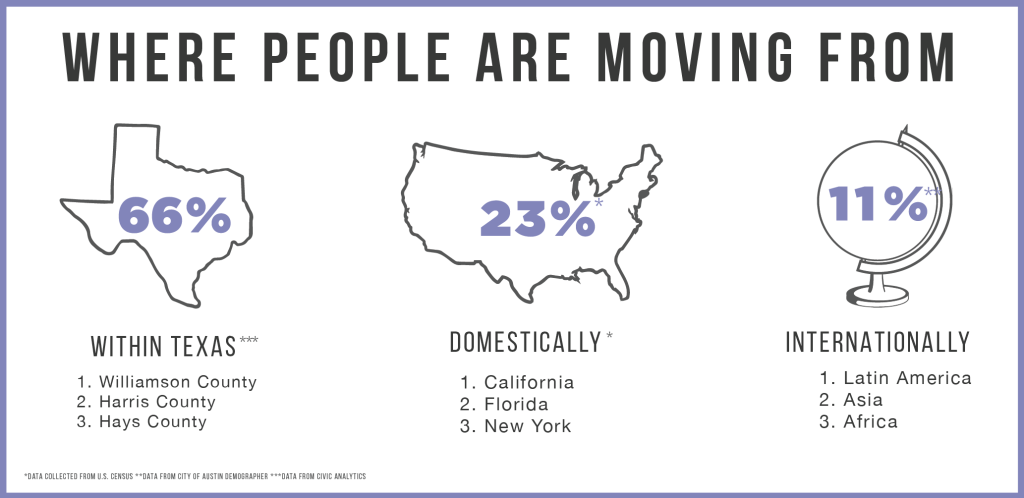There is no doubt that the cat is out of the bag on Austin. We are a great place to live and seem to be on every top ten list for every conceivable reason. Time and again media outlets report over 140 people a day move to Austin. What does that actually mean and where are the “people” coming from?
After factoring in the number of people who leave Austin, the greater Austin metro area is growing by 110 people per day according to Ryan Robinson, Demographer with the City of Austin. Perhaps surprising to many, the majority come from right here in Texas, with the largest percentage of being residents of Williamson County moving to Travis County (19%). “My sense has always been that Austin gets a lot of two-step migrants. First they move from New York to Houston or California to Dallas; then realize that where they really want to be is in Austin,” says Robinson.
However 23% of newcomers do make Austin their first step and arrive directly from out of state. The lack of state income tax and Austin’s welcoming business environment, seems to have especially drawn the attention of many California based business owners and home buyers. In addition, we have noticed that the recent hard winters in the north have driven some buyers to our friendly climate.Census data from 2008-2012 confirms that some of our biggest out of state markets for transplants are California, Florida and New York. Gottesman Residential’s website data echos this with the majority of our 35,754 / annual out-of-state web visits coming from New York and California.
The Gottesman Residential website also reflects international interest, with views coming from 132 countries this year. While the international interest in Austin is widespread and Austin has been put on the global map with international events such as South by Southwest, The X Games, Formula One and Austin City Limits Festival, we have yet to see the large influx of luxury, international buyers as was originally anticipated.
According to Robinson, 11% of migrants to Austin in 2014 have come from outside of the United States, which significantly dropped from the 23% of migrants being from foreign countries between 2000-2010. Part of the reason for this may be the lack of ease in getting to Austin. While we now have an international airport, the number of direct flights available to Austin from other major cities is limited. Charles Heimsath, President of Capitol Market Research which specializes in real estate research, suggests that as Austin adds more direct flights, specifically international flights, we should anticipate seeing this demographic rise.
The next question is: What does this mean for Buyers and Sellers in the Austin real estate market? While Austin has small town roots, there is no doubt that it is now a fast paced real estate market whether growing from local population movement or new transplants to the state, and it is an exciting time to live in and own a home in Austin. “Just like all politics is local, all real estate is local. Whether buying or selling, local knowledge in the area is essential,” says Heimsath. Austin has continuously bucked national and state housing trends. Therefore, approaches to buying and selling in New York or Dallas for example, may not be effective in Austin. And relying on publicly available, online data alone, may not be sufficient. In–depth, local knowledge of our market and experienced guidance will be key for people looking to both buy and sell.

